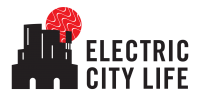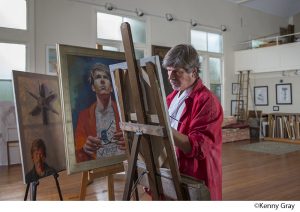
Written by Mamie Pound
Photos by Kenny Gray
I interviewed Garry on Sunday, July 3, after a neighborhood volleyball game. He’s played with these same Historic District neighbors for twenty years, every Sunday afternoon. Sweaty and covered in empty-lot dirt, he feeds pea-sized bites of canned cat food to a chimney sweep, temporarily housed in a copper pot on our porch. It was the third one that fell into our fireplace that week. He then poured himself a beer and was just on his way upstairs to watch some horrible show on Netflix, when I asked him to sit for an interview.
What influence has your family had on you as an artist?
Both parents were artists. Art and culture was central to my environment growing up. Family life instilled in me an intellectual and aesthetic curiosity that has been a mainstay of my creativity. My strong grounding in this community allowed me to make a career here with a base of supporters. Columbus has been really supportive over the years. I was lucky to have been able to get out of graduate school and start painting right away.
Where do you find the most inspiration?
Inspiration comes from work. The more I work, the more the ideas flow. It’s all in the process and discipline of doing something creative every day.
What other artist inspires you?
I have a humanities degree and have “stolen” inspiration from any artist I could. As Picasso said, “Good artists borrow ideas, great artists steal them.” I’m always amazed and inspired by John Singer Sargent, Caravaggio, Vermeer’s sense of light. Being a student of abstract expressionism has made me appreciate the sense of gesture in rendering portraits and figures. It’s helped me infuse a sense of animation into my paintings.
What’s your favorite medium?
Drawing would have to be my first love. Then oil painting. Drawing because I’m good at it, but also because it is where you develop your craft, your artistic awareness and sensitivity. It’s the most immediate, most intimate art. I always carry a notebook, pencil and pens wherever I go. That’s all you need to draw.
You draw in pen a lot, I notice. Don’t you want to be able to erase?
Mistakes are happy accidents and if you are smart, you incorporate them into your design. Who wants a perfect drawing anyway? What is important is connecting with the outside world, drawing what’s right in front of you. Drawing is an exercise in seeing and being aware.
What’s it like to draw a naked human?
It’s drawing people the way God made them. Drawing the nude is coming to grips with human form. You have to pay attention. You can’t “cheat”, can’t hide behind clothing.
What’s the most difficult thing to draw?
Sargent said the a portrait was “a picture of someone with a little something wrong with their mouth.” The mouth is the most mobile, most expressive part of the face. If you change the mouth, the whole face changes. Then again, anything is difficult to draw if you are not paying attention.
So what’s the secret to being able to draw well?
Practice. You have to draw what you see, versus what you think it should look like. Do 10,000 drawings and you are almost there. It is all about awareness, getting outside yourself and into the subject you are trying to render, then translating that experience into your fingertips and onto the paper.
What other art inspires you?
Music— especially jazz, English Folk, classical, Alternative (Bach is transcendent). And literature— I love a great story with characters I care about.
Your studio has a history of it’s own. I suppose you could say it’s where art and preservation intersect. It must be quite fantastic to make art in a studio with 30 foot ceilings?
My first studio space in Columbus was in Rankin Square in the 1970’s.
In the early 1980’s, in the Iron Bank Building at Broadway and 11th Street. In the mid-1980’s in the old Empire Building on the corner of First Avenue and 12th Street. By the late 1980’s, I’d renovated 730 First Avenue and my studio was there. After the 1996 Olympics, I bought the headquarter office at 100 Seventh Street, the old Shearith Temple, c. 1890. They’d converted it to an office building with dropped ceilings, cubicles, etc.. It is the oldest standing former synagogue in Columbus. My renovation uncovered the original lines and spaces of the structure. There’s a calming spiritual feeling to it. I credit its first inhabitants for that. The light in the main painting room is just about perfect.
What do you remember about the early art scene in Columbus?
My mom taught at the Columbus Museum and when I wasn’t being used as a model for her drawing classes, I had free reign in the museum. As a kid, I was fascinated by the Indian exhibits, Dexter Jordan, Sr.’s gun collection, and the artistic nudes. I don’t know what that says about my early development. I was able to take workshops there with artists like Zolton Zabo, Betty Edwards, George Cress and Blue Sky (I remember that Blue Sky was against putting any artificial stimulants in your body, and he had a mutiny in his workshop when he banned the drinking of Coffee by the participants). Gerry Bosch would walk around and give extemporaneous art talks at the museum. I wanted to do that—be able to competently explain a work of art. It was a vibrant time. We had artists like my Mom and Mary Passalaigue, Edward Shorter, Mr. Mani, Marge Tilley, Jamie Howard, George Goddard, Gerald Heathcock, Donna Maddox and Henry Nordhausen here in town. These artists were the foundation of that first art scene here. It jumpstarted the college art department. They worked quietly behind the scenes. It was they, along with a devoted and passionate group of Columbus patrons, who formed the basis for a fine arts resurgence in Columbus.
Originally posted on Columbus Artists Magazine

